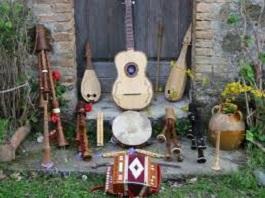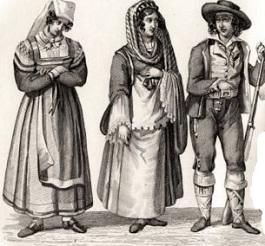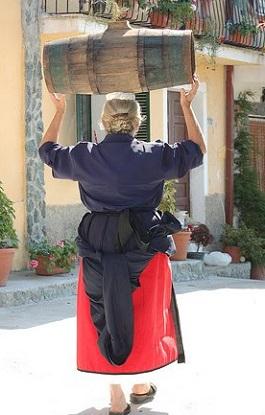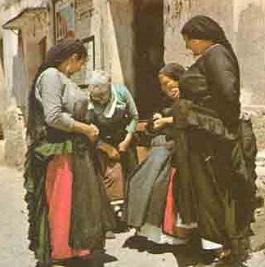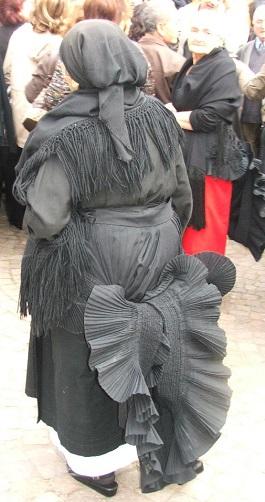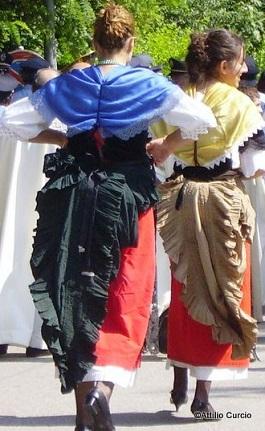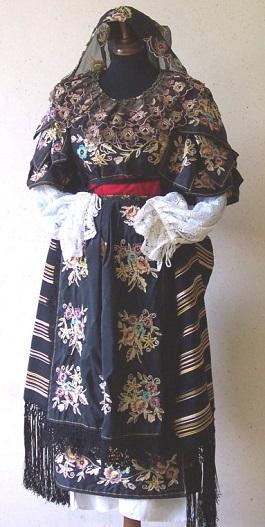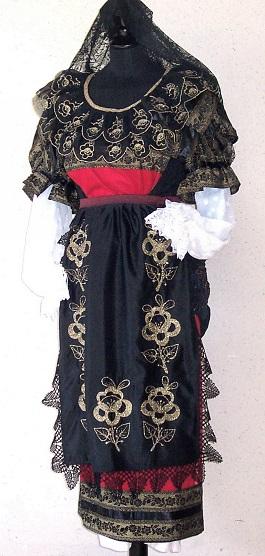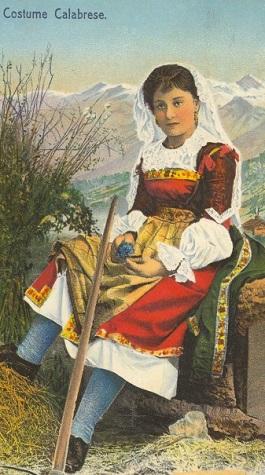A Viddhaneddha
The street dance - Culture, sounds, traditions and sunshine ... This is Calabria.
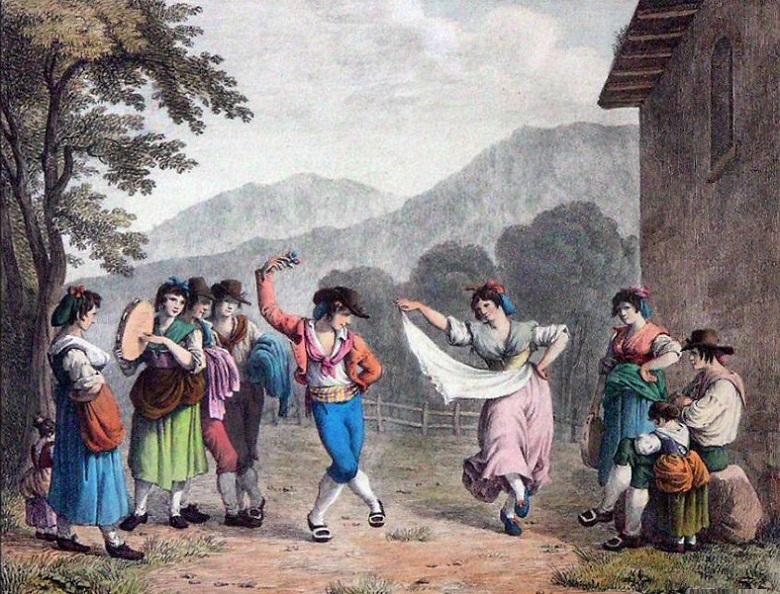
Among the most unique pieces of Calabria is a typical street folk dance called "Viddhaneddha", (narrow street, old people in the Grecanic areas call it megalo koro), which originated in rituals coming from Magna Graecia, with liberating rhythm and aggressive gestures of courtship and competition that create very choreographic attitudes.
This dance is superficially defined as a subspecies of tarantella; indeed, musical features are similar to the tarantellas of Apulia and Rome, but while in the latter there is a rhythmic meter characterized by a continuity of the "three plus three" (1-2-3, 1-2-3 with no pause) stresses, in viddhaneddha these stresses are interspersed with pauses, that is the rhythm of the tambourine , 1-2-3-pause, 1-2-3-pause.
Let the dance begin - Attaccati cumpari Peppi!
|
|
A charismatic leader, the dance master (mastru d'abballu), is chosen, and as the music starts the master takes his position at the center of the circle, then heads to the audience to choose a partner, inviting him with a slight bow, as a sign of respect the dancer greets the women by touching his forehead with the fingers of his right hand.
After some rounds he invites another dancer from among the public to take his place by calling loudly "fora 'u primu" or "tagghialu" (out the first or cut him out - audible in the video below), and so on until the end of the dances. Tarantella dancing, albeit strictly codified and limiting physical contact, represented a rare opportunity for men and women not bound by kinship to relate publicly. The tarantella can thus be seen both as propitiatory of fertility and as a ritual of controlled abandonment to instinct/inner pulsation.
The steps and behavior of the dancers clearly suggest a Greek  origin. origin.
The tempo or rhythmic is given by the tambourine, (which originated from the  tympanum) in imitation of Hellenic castanets, or by the clapping hands of the dancers. tympanum) in imitation of Hellenic castanets, or by the clapping hands of the dancers.
The dance can be both woman to man (courtship), or man to man (duel and supremacy).
In a dance with a mixed couple (man and woman), there takes place a mimicking of courtship, innuendos and desires.
Dancing men and women are usually arranged along the edge of the circle facing each other.
The first dance steps are slow: he stares into her eyes, she looks down, her hands on her hips with palms facing outward, a position full of coquetry that enhances the hips and breasts.
After some outside rounds, the pair go to the center: the man sometimes claps the rhythm with his hands, sometimes tries to go around the woman.
She retreats with the "tagghiapassu" or pirouettes to escape the siege and to always face the man.
Sometimes she raises an arm above her head in the "scartagnetta", that is following the rhythm snapping her fingers, sometimes slides "u muccaturi" (foulard) around her neck or shakes it in the face of her companion.
He always tries to impress her with the ability of his steps and then "scapigghiarla" (that is taking her foulard which was also used as head cover).
Sometimes the couple dances shoulder to shoulder in direct contact, but in this case the "mastru d'abballu" (dance master) can come in, at the request of the girl's relatives and replace the male dancer.
The dances last long, with haunting, enthralling rhythm, also 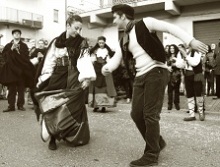 thanks to the abundance of wine in "bumbuli" (oval earthenware jars), offered to quench the thirst.
In a man-to-man dance, first of all a circular space for the dance is marked, a symbolic evocation of a tribal territory, which was to be conquered and defended. thanks to the abundance of wine in "bumbuli" (oval earthenware jars), offered to quench the thirst.
In a man-to-man dance, first of all a circular space for the dance is marked, a symbolic evocation of a tribal territory, which was to be conquered and defended.
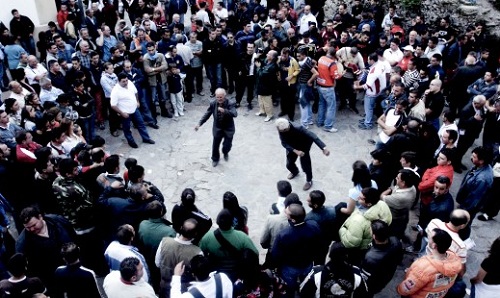 The dancing steps follow a ritual.
The pair formed under the command of the master start dancing for the possession of the circle.
The contestants are arranged around the circumference and, looking at each other, try to imitate steps.
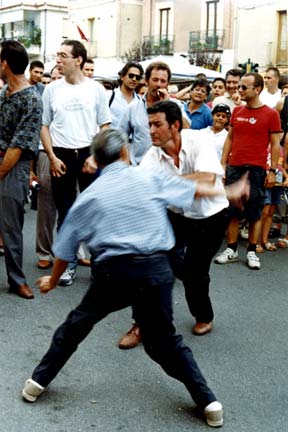 The purpose is to push the opponent to the center of the circle. The purpose is to push the opponent to the center of the circle.
The movements of the upper and lower body, ideally divided into two at the waist, the legs frantically increase speed, while the trunk is mostly static, just swaying.
Sometimes a finger is pointed upwards in defiance.
Other times dancers try to impress and confuse the partner with a "soprapasso" (overstep), a difficult dance step made crossing feet and hitting the ground with one foot outside the other alternately.
When one of the contenders wins the rim, he begins the "passo 'ill'adornu", that is an imitation of a falcon's flight over its prey: the dancer follows
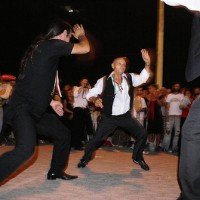 a spiraling route driving the opponent toward the center. a spiraling route driving the opponent toward the center.
If the latter is defeated he goes to the center, slowing the pace of steps and lowering the arms, and is replaced.
At times, faking a defeat, they to stop the adversary with a "tagghiapassu" (cutting the way-cut him out).
At this point the "schermiata" (the dance of the sword, duel) begins, with the right hand fingers mimicking a knife and the left hand lower, to block any blows.
In the past this dance could become dangerous for the use of sticks by the dancers.
(This was a ritual very dear to the local organized criminal groups (Ndrangheta), and was usually choreographed to "send a message" to opponents, and more then often "things" did happen right during the dance...)
...its in the blood...not much you can do about it.
... a scent of a time gone by
Come to Calabria... and dance...and sing with us...
|
Typical instruments Calabresi
Image below :
"A viddhaneddha" typical neighborhood street from which the dance took its name.
Easy to imagine why it assumed such variety of symbols and meanings with people living in such close quarters and without any other form of distractions.
The picture is from the town of Diamante in the province of Cosenza.
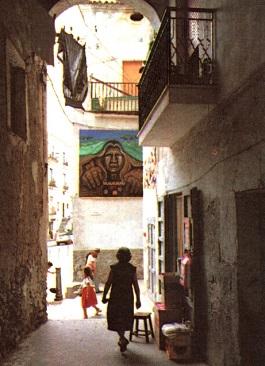 The costumes
The costumes
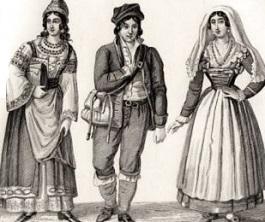
|
| |
La vetrina ideale per promuovere i vostri prodotti e servizi sul mercato Nord Americano ma che potrebbe essere un punto di visibilità anche nei vari mercati internazionali.
AZIENDE - PRODUTTORI - STRUTTURE RICETTIVE - GUIDE TURISTICHE - TOUR OPERATORI
Ai nostri visitatori piace il Sud Italia, vuoi dire loro qualcosa?
Il nostro obiettivo e' quello di promuovere prodotti tipici del Sud in un contesto di marketing globale, e allo stesso tempo proporre
il nostro Meridione come alternativa turistica, ben consapevoli che il successo dell'uno è essenziale per il successo dell'altro.
Paesi di provenienza dei visitatori in ordine numerico
Stati Uniti - Canada - Italia - Gran Bretagna - Australia - China - Germania - Francia - Nuova Zelanda - Olanda
Coloro interessati ad inserire la loro attivita'/azienda/ nel sito
sono pregati di mettersi in contatto usando il modulo sottostante .
Per saperne di piu'...

|





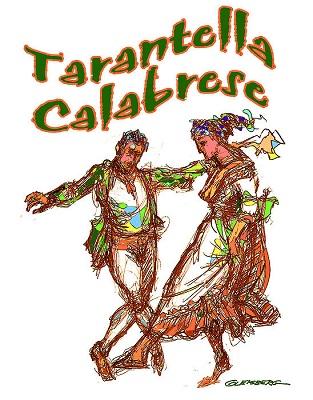

 tympanum)
tympanum) thanks to the abundance of wine in
thanks to the abundance of wine in 


